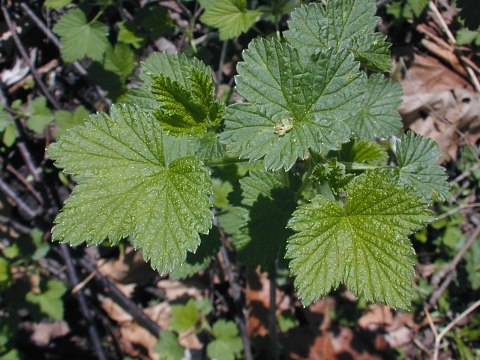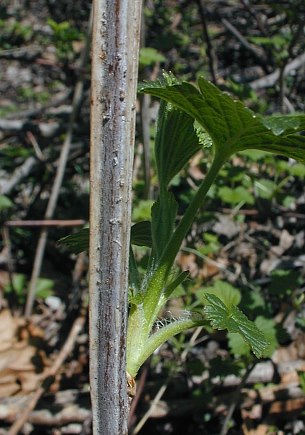Description: This shrub produces little-branched woody stems about 3-5' tall that are erect, ascending, to slightly arching. The base of older stems is reddish brown or reddish black with white lenticels; otherwise, stems are medium gray and winged with light brown woody ridges. Young non-woody shoots are light green, terete, and hairy. Alternate leaves develop along the shoots. The blades of these leaves are about 1½-3½" long and similarly across; they are orbicular in outline, but palmately lobed (3 or 5 lobes). The margins of the blades are coarsely and irregularly toothed and sometimes shallowly cleft. The upper blade surface is medium to dark green, glabrous, and variably wrinkled from sunken veins; the lower blade surface is light green and hairy, particularly along the veins. Both the lower and upper surfaces of the blades have minute glandular dots that are gold-colored. The petioles are up to 3" long, light green, and hairy.

Occasionally,
short lateral shoots from the stems terminate in drooping racemes of
flowers about 1-3" long. Each raceme has 5-15 flowers that are arranged
alternately along the central stalk; at the base of each flower, there
is a linear-oblong bract about 1/3" long (8 mm.) that is somewhat
recurved and ciliate. The central stalk of each raceme is light green
and pubescent. Individual flowers are about 1/3" (8 mm.) long or
slightly longer, consisting of a green inferior ovary, a greenish white
to pale yellow tubular calyx with 5 spreading lobes that are oblong in
shape, 5 erect whitish petals that are largely hidden by the lobes of
the sepals, 5 non-exerted stamens, and 2 united styles that become
divergent at their tips. The jointed pedicels are 1/8" (3 mm.) long or
less.
The blooming period occurs from mid- to late spring and lasts about 3
weeks. Fertile flowers are replaced by fleshy berries. Individual
berries are 1/3" (8 mm.) across or a little wider, ovoid to globoid in
shape, and shiny. Immature berries are green, while mature berries are
black. Each berry contains numerous minute seeds that are ovoid and
somewhat flattened.

Cultivation:
The preference is partial sun, consistently moist conditions, and cool
to moderate temperatures; the soil can contain loam, clay, sand, or
rocky material. This woody plant is one of the hosts of White Pine
Blister Rust.
Range & Habitat:
The native Wild Black Currant is occasional in northern Illinois,
uncommon in central Illinois, and absent in the southern section of the
state (see Distribution
Map). Habitats consist of both typical and sandy swamps,
typical and sandy sedge meadows, fens and seeps, partially shaded
streambanks, low areas of moist ravines and rocky canyons, and open
woodlands. This woody plant is usually found in less disturbed habitats
that receive partial shade.
Faunal Associations:
The nectar and pollen of the flowers attract bumblebees, little carpenter bees (Ceratina spp.),
Halictid bees (Lasioglossum spp.), and an
oligolectic bee, Andrena nivalis (Graenicher, 1907; Wilhelm & Rericha, 2017). Several insects
feed on the foliage and other parts of Wild Black Currant and other Ribes
spp. These insect feeders include the caterpillars of the
butterflies Polygonia faunas (Green Comma) and Polygonia
progne (Gray Comma), the caterpillars of Dysstroma
hersiliata (Orange-Barred Carpet) and other moths, Cryptomyzus
ribis (Currant Aphid) and Nasonovia ribisnigri
(Lettuce Aphid), Poecilocapsus lineatus (Four-Lined
Plant Bug) and Taedia colon (Plant Bug sp.), the
larvae of the wood-boring beetles Agrilus aurichalceus
(Bronze Cane Borer) and Psenocerus supernotatus
(Currant Tip Borer), the leaf beetles Altica ribis
and Tricholochmaea ribicola, larvae of the
two sawflies, Nematus ribesii (Imported Currantworm) and
Janus integer (Currant Stem Girdler), larvae of Euphantra canadensis (Currant Fruit Fly), and several scale insects.
See the Insect Table for a more complete listing of these species. Another
invertebrate species, Cecidophyopsis psilaspis
(Currant Bud Mite), causes galls to form on the buds. Both birds and
mammals eat the berries of Ribes spp.
and help to
distribute their seeds into new areas. Among mammals, these species
include the Raccoon, American Black Bear, White-footed Mouse, and
Woodland Deer Mouse (Martin et al., 1951/1961; Noyce & Coy, 1990;
Hamilton, 1941).
Berry-consuming birds include the Northern Catbird, Brown Thrasher,
American Robin, Hermit Thrush, Wood Thrush, Eastern Bluebird, and
extinct Passenger Pigeon (Martin et al., 1951/1961; Beal, 1915;
Schorger, 1955). White-Tailed Deer occasionally
browse on the twigs and foliage (personal observation).

Photographic
Location:
The photograph of the flower and berry was taken at a sandy swamp of
the Oak Openings Nature Preserve in NW Ohio. The photographs of the
woody stem and young leaves were taken at a shaded seep of the
Horseshoe Bottoms in Vermilion County, Illinois.
Comments:
The edible berries of Wild Black Currant can be used to make jelly,
wine, or pie; they can also be used to flavor black tea.
Notwithstanding the palatability of its berries, the black currant that
is commonly cultivated for fruit is the European species, Ribes
nigrum (Black Currant). Unlike many other Ribes spp.,
Wild Black Currant lacks prickles as protection against herbivores.
This native species can be identified by its odd-looking stems (gray
with brown woody wings), the glandular golden dots on its leaves, its
black berries, and the structure of its flowers (long tubular calyx
with petaloid lobes, non-exerted stamens, etc.).